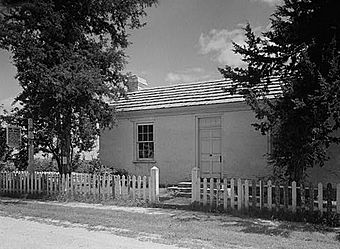George Caleb Bingham House facts for kids
|
George Caleb Bingham House
|
|
|
U.S. National Historic Landmark District
Contributing Property |
|

George Caleb Bingham House in 1942
|
|
| Location | Arrow Rock, Missouri |
|---|---|
| Area | less than one acre |
| Built | 1837 |
| Architect | George Caleb Bingham |
| Architectural style | Federal |
| Part of | Arrow Rock Historic District (ID66000422) |
| NRHP reference No. | 66000423 |
Quick facts for kids Significant dates |
|
| Added to NRHP | 15 October 1966 |
| Designated NHL | December 21, 1965 |
| Designated NHLDCP | 23 May 1963 |
The George Caleb Bingham House is a special old house located in Arrow Rock, Missouri. It's part of the Arrow Rock State Historic Site. This house was built in 1837 and was the main home for a very famous American painter named George Caleb Bingham. He lived here from 1837 to 1845. Because of its history and connection to Bingham, it was named a National Historic Landmark in 1965.
Contents
Discovering the Bingham House
The George Caleb Bingham House sits in the historic village of Arrow Rock. You can find it near the eastern edge of the village. It's located where 1st Street and High Street meet. This property is also part of the larger Arrow Rock State Historic Site.
What Does the House Look Like?
The house is a small, one-story building made of brick. It has a simple design with three windows on the front. The roof slopes down on the sides, and there are chimneys built into the walls. The main part of the house has two rooms. There's also a wooden addition at the back.
Who Was George Caleb Bingham?
George Caleb Bingham was a talented artist. He was known for painting portraits of people and beautiful landscapes. He especially loved to paint scenes and people from the Missouri frontier. He built this house in 1837 when he was newly married and just starting his career. He lived here off and on until 1845. It was in this very house that he developed his unique painting style. His art captured the spirit of early American life.
The House's Journey Through Time
After Bingham moved out, the house changed quite a bit. By 1870, it was made larger, and a second story was added. In 1926, someone who cared about history bought the house. Then, in 1934, the state of Missouri took ownership.
The house went through a big restoration project. This project removed all the additions, bringing it back to its original brick core. Later, in 1964 and 1965, it had another careful restoration. The goal was to make it look like it did when Bingham lived there. This was tricky because there weren't many old documents showing exactly how it looked back then.
More to Explore



